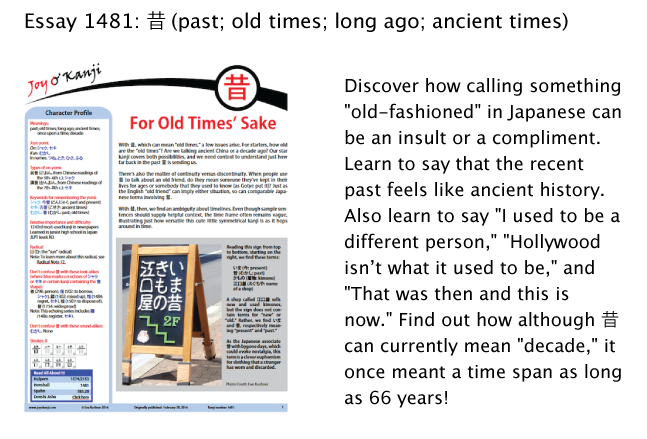Making the Flowers Bloom
Today I present Part 2 of a three-part quiz. As I mentioned last week with Part 1, I didn't create this challenge; rather, proofreader Ryoichi Chida brought it to my attention. The questions come from a difficult quiz called 日能研 (にちのうけん) that 12-year-olds in Japan can take.
Here are three clues:
A. 一挙両得
B. 蝦で鯛をつる
C. ぬれ手で粟
Figure out what each one means, and think of a two-kanji word that ties them together thematically. Then locate that word in the following grid:

I'll supply the answers below.
In the meantime, I'd like to share two nuggets from the new essay 1481 on 昔 (past; old times; long ago; ancient times; decade).
For starters, there's this wonderful expression:
花を咲かせる (はなをさかせる: to have fun talking about something)
flowers + to make bloom
Making the flowers bloom?! What power conversationalists must have in Japan! The flowers in this case are like the fruits of one's discussion, only prettier!
Then there's this word, which sounds a lot like the terms for "octopus" and "kite":
たこ (callus; corn)
So far this term is a bit unpleasant (at least compared with the blooming flowers we just saw), but the Japanese do something quite clever with it. I'm talking about the red turn of phrase tucked inside this sentence:
お祖母さんの昔話は耳にタコができるほど聞かされた。
I've heard my grandmother's stories so often that I'm really sick of them.
お祖母さん (おばあさん: grandmother); 昔話 (むかしばなし: reminiscence);
聞く (きく: to hear, shown here in its causative-passive form)
Here's what the red part means:
耳にタコができる (みみにタコができる: to be told or made to hear something so often that you metaphorically get calluses on your ears)
Ha! What an imaginative complaint!
Here, by the way, is a preview of essay 1481, the setting for these gems:

I just took a three-second Facebook break and saw this bit of wisdom: "Patience is not about how long you can wait. It's about how you behave while waiting." Have you behaved well while waiting for the quiz answers? Even if you haven't, here they are:
A. 一挙両得 (いっきょりょうとく: 1 + action + 2 + benefits) means "trying to kill two birds with one stone, only to end up with nothing."
B. 蝦で鯛をつる (えびでたいをつる: shrimp + red snapper + to fish (つる)) literally means "to use shrimp to fish for red snapper." This a bit misleading because, at least where I live, shrimp are large and valuable (except perhaps for those tiny, pink, tasteless ones that people serve cold). To make matters more confusing, 蝦 can mean "lobster"! Nevertheless, you're supposed to visualize it as something small here. My proofreader says that 蝦 means "small fry" in this case. He paraphrases 蝦で鯛をつる as "To use small fry to catch a whale" or "A small gift often brings a great reward" or "“Use a small investment to net a huge profit.” Oh, finally we're out of the sea, and the aphorism becomes clearer!
If you can tolerate going back into the sea just for a moment, I've learned something helpful. Wikipedia says that the red snapper likes to eat small fish and crustaceans. That must be the origin of the saying.
Incidentally, both 蝦 and 鯛 are non-Joyo. Those 12-year-olds are expected to know a great deal!
C. ぬれ手で粟 (ぬれてであわ: wet hands (ぬれ手) + millet) literally means "picking up millet with wet hands." Holding grain becomes considerably easier when your hands are wet. Thus, ぬれ手で粟 figuratively means "raking in profits and getting rich quickly." Again, 粟 is non-Joyo.
Do you see a thread connecting the three clues? The word to find in the grid is 利益 (りえき: profit, benefit, advantage).
I hope this discussion has been profitable for you! Have a great weekend!
Oh, by the way, Part 3 of the 日能研 quiz is in the February Joy o' Kanji newsletter!

Comments